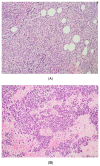Case Report of Small Cell Carcinoma of the Ovary, Hypercalcemic Type (Ovarian Rhabdoid Tumor) with SMARCB1 Mutation: A Literature Review of a Rare and Aggressive Condition
- PMID: 35200537
- PMCID: PMC8870484
- DOI: 10.3390/curroncol29020037
Case Report of Small Cell Carcinoma of the Ovary, Hypercalcemic Type (Ovarian Rhabdoid Tumor) with SMARCB1 Mutation: A Literature Review of a Rare and Aggressive Condition
Abstract
Small cell carcinoma of the ovary, hypercalcemic type (SCCOHT) is a rare and aggressive condition that is associated with the SMARCA4 mutation and has a dismal prognosis. It is generally diagnosed in young women. Here, we report a case of a young woman with SCCOHT harboring a rare molecular finding with a highly aggressive biological behavior. The patient had a somatic SMARCB1 mutation instead of an expected SMARCA4 alteration. Even though the patient was treated with high-dose chemotherapy followed by stem cell transplantation, she evolved with disease progression and died 11 months after her first symptoms appeared. We present a literature review of this rare disease and discuss the findings in the present patient in comparison to expected molecular alterations and options for SCCOHT treatment.
Keywords: SMARCB1 mutation; hypercalcemic type; ovarian cancer; small cell carcinoma of the ovary.
Conflict of interest statement
The authors declare no conflict of interest.
Figures











Similar articles
-
SMARCA4-deficient rhabdoid tumours show intermediate molecular features between SMARCB1-deficient rhabdoid tumours and small cell carcinomas of the ovary, hypercalcaemic type.J Pathol. 2021 Sep;255(1):1-15. doi: 10.1002/path.5705. Epub 2021 Jun 23. J Pathol. 2021. PMID: 33999421
-
Biallelic somatic SMARCA4 mutations in small cell carcinoma of the ovary, hypercalcemic type (SCCOHT).Pediatr Blood Cancer. 2015 Apr;62(4):728-30. doi: 10.1002/pbc.25279. Epub 2014 Oct 12. Pediatr Blood Cancer. 2015. PMID: 25307865
-
Molecular analyses reveal close similarities between small cell carcinoma of the ovary, hypercalcemic type and atypical teratoid/rhabdoid tumor.Oncotarget. 2016 Jan 12;7(2):1732-40. doi: 10.18632/oncotarget.6459. Oncotarget. 2016. PMID: 26646792 Free PMC article.
-
Small-Cell Carcinoma of the Ovary of Hypercalcemic Type (Malignant Rhabdoid Tumor of the Ovary): A Review with Recent Developments on Pathogenesis.Surg Pathol Clin. 2016 Jun;9(2):215-26. doi: 10.1016/j.path.2016.01.005. Epub 2016 Apr 12. Surg Pathol Clin. 2016. PMID: 27241105 Review.
-
[Pathological and molecular features of malignancies underlined by BAF complexes inactivation].Ann Pathol. 2019 Dec;39(6):399-413. doi: 10.1016/j.annpat.2019.05.001. Epub 2019 Jun 27. Ann Pathol. 2019. PMID: 31255411 Review. French.
Cited by
-
A Case of Hypercalcemic-Type Stage IVB Small-Cell Carcinoma of the Ovary in a Young Woman.Cureus. 2024 Apr 28;16(4):e59214. doi: 10.7759/cureus.59214. eCollection 2024 Apr. Cureus. 2024. PMID: 38807834 Free PMC article.
-
Prognosis comparison between small cell carcinoma of ovary and high-grade serous ovarian cancer: A retrospective observational cohort study.Front Endocrinol (Lausanne). 2023 Jan 18;14:1103429. doi: 10.3389/fendo.2023.1103429. eCollection 2023. Front Endocrinol (Lausanne). 2023. PMID: 36742399 Free PMC article.
-
A case report of small cell neuroendocrine carcinoma of the ovary and review of the literature.Front Immunol. 2025 May 22;16:1569011. doi: 10.3389/fimmu.2025.1569011. eCollection 2025. Front Immunol. 2025. PMID: 40475766 Free PMC article. Review.
-
Nomograms for Predicting Overall Survival and Cancer-Specific Survival of Small Cell Carcinoma of Ovary Patients: A Retrospective Cohort Study.World J Oncol. 2025 Jun;16(3):317-330. doi: 10.14740/wjon2543. Epub 2025 Apr 22. World J Oncol. 2025. PMID: 40556961 Free PMC article.
-
Compound cancer with small cell carcinoma and mucinous adenocarcinoma of the ovary: a case report and literature review.Front Oncol. 2025 Feb 25;15:1500088. doi: 10.3389/fonc.2025.1500088. eCollection 2025. Front Oncol. 2025. PMID: 40071085 Free PMC article.
References
-
- Tischkowitz N., Huang S., Banerjee S., Hague J., Hendricks W.P., Huntsman D.G., Lang J.D., Orlando K.A., Oza A.M., Pautier P., et al. Small-Cell Carcinoma of the Ovary, Hypercalcemic Type–Genetics, New Treatment Targets, and Current Management Guideline. Clin. Cancer Res. 2020;26:3908–3917. doi: 10.1158/1078-0432.CCR-19-3797. - DOI - PMC - PubMed
-
- Ramos P., Karnezis A.N., Craig D.E., Sekulic A., Russell M.L., Hendricks W.P., Corneveaux J.J., Barrett M.T., Shumansky K., Yang Y., et al. Small cell carcinoma of the ovary, hypercalcemic type, displays frequent inactivating germline and somatic mutations in SMARCA4. Nat. Genet. 2014;46:427–429. doi: 10.1038/ng.2928. - DOI - PMC - PubMed
Publication types
MeSH terms
Substances
LinkOut - more resources
Full Text Sources
Medical
Miscellaneous

